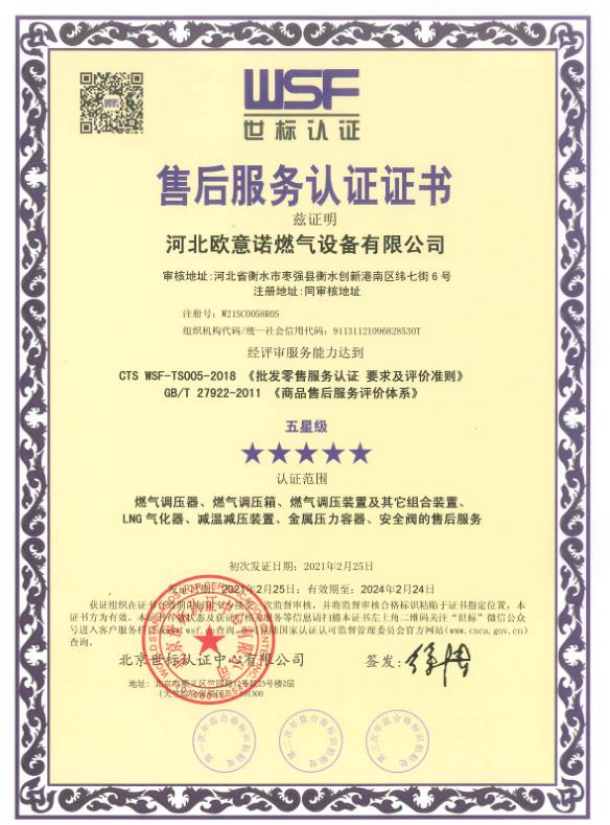
Oct . 16, 2024 15:40
Back to list
Gas Control Valve Optimization for Enhanced Performance and Safety Solutions
Understanding Gas Valves Function, Types, and Applications
Gas valves are essential components in various systems where gas is involved, from household appliances to industrial machinery. Their primary function is to control the flow of gas, ensuring that it is safely and effectively managed. This article delves into the importance of gas valves, the different types available, and their common applications.
Function of Gas Valves
The primary role of gas valves is to regulate the flow of gas in a system. This regulation can involve turning the gas flow on or off, as well as modulating the flow rate. By doing so, gas valves help maintain the desired pressure and temperature, which are crucial for the safe operation of gas systems.
In residential settings, gas valves are commonly used in appliances like stoves, heaters, and water boilers. In these appliances, they ensure that gas is only supplied when needed, reducing the risk of leaks and ensuring efficient operation. In industrial applications, gas valves can control larger volumes of gas in processes such as combustion, chemical production, or heating systems.
Types of Gas Valves
There are several types of gas valves, each designed for specific applications and operating conditions. Here are the most common types
1. Manual Gas Valves These valves are operated by hand using a lever or handle. They are often used in domestic appliances or systems where manual operation is sufficient. While manual gas valves are simple and reliable, they require human intervention to open or close the gas flow, which may not be ideal for all applications.
2. Automatic Gas Valves Unlike manual valves, automatic gas valves are controlled by electronic or pneumatic signals. These valves can respond to changes in pressure, temperature, or flow rate without human intervention. Automatic valves are commonly used in industrial systems where precise control is necessary for safety and efficiency.
gas valve

3. Solenoid Valves This type of automatic valve uses an electromagnetic coil to control the flow of gas. When the coil is energized, it creates a magnetic field that opens or closes the valve. Solenoid valves are often used in applications where quick response times are essential, such as in gas-fired heating systems or automated manufacturing processes.
4. Regulating Valves These valves are designed to maintain a constant pressure or flow rate in a gas system. They adjust the size of the opening based on real-time pressure measurements, ensuring that the downstream equipment receives gas at the desired pressure. Regulating valves are crucial in applications where maintaining specific conditions is vital to safety and performance.
5. Safety Valves These valves are designed to prevent overpressure situations that can lead to dangerous conditions or explosions. Safety valves automatically relieve excess pressure by venting gas to the atmosphere, thereby protecting the system and its components.
Applications of Gas Valves
Gas valves find applications across various sectors, including residential, commercial, and industrial domains.
In residential settings, they are most commonly found in kitchen appliances like gas stoves and ovens, where they control the gas supply for cooking. Additionally, they play a vital role in heating systems, such as furnaces and water heaters, ensuring efficient operation and safety.
In the industrial sector, gas valves are critical in processes like oil refining, chemical manufacturing, and power generation. These processes often involve high pressures and temperatures, requiring robust and reliable gas valve systems. Furthermore, in the energy sector, gas valves are crucial for pipelines transporting natural gas, ensuring flow control and safety throughout the distribution network.
Conclusion
Gas valves are integral to the safe and efficient operation of systems that utilize gas. Understanding their functions and types helps prevent hazards related to gas leaks, explosions, and improper system operation. Whether in residential appliances or complex industrial processes, gas valves play a crucial role in ensuring that gas is used safely and effectively. As technology advances, the design and capabilities of gas valves will likely continue to evolve, enhancing safety and efficiency in various applications.
Latest news
-
Safety Valve Spring-Loaded Design Overpressure ProtectionNewsJul.25,2025
-
Precision Voltage Regulator AC5 Accuracy Grade PerformanceNewsJul.25,2025
-
Natural Gas Pressure Regulating Skid Industrial Pipeline ApplicationsNewsJul.25,2025
-
Natural Gas Filter Stainless Steel Mesh Element DesignNewsJul.25,2025
-
Gas Pressure Regulator Valve Direct-Acting Spring-Loaded DesignNewsJul.25,2025
-
Decompression Equipment Multi-Stage Heat Exchange System DesignNewsJul.25,2025

